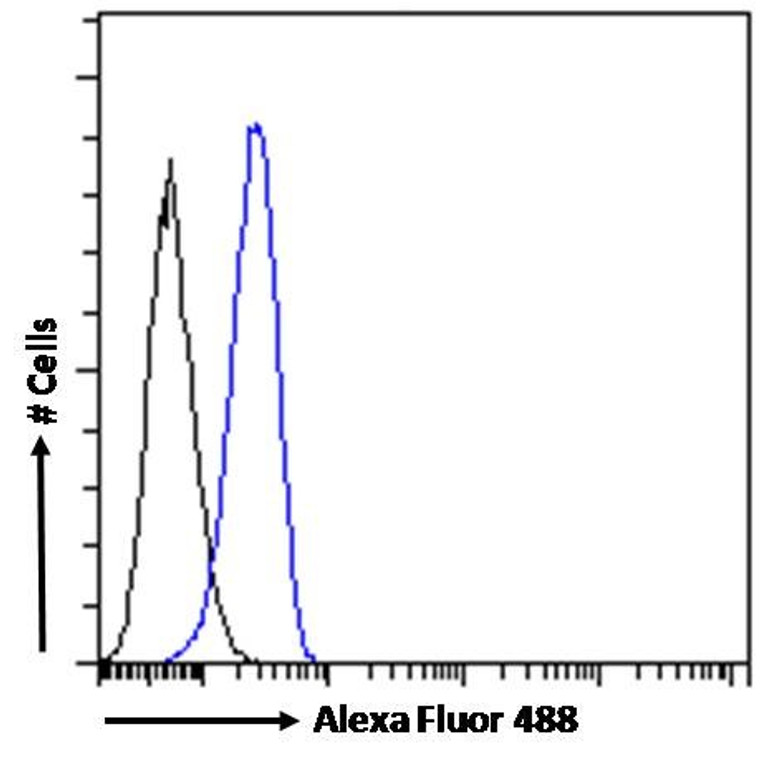| Host: |
Goat |
| Applications: |
Pep-ELISA/IF/IHC/FC |
| Reactivity: |
Human/Mouse/Rat |
| Note: |
STRICTLY FOR FURTHER SCIENTIFIC RESEARCH USE ONLY (RUO). MUST NOT TO BE USED IN DIAGNOSTIC OR THERAPEUTIC APPLICATIONS. |
| Short Description: |
Goat polyclonal antibody anti-TLR4/CD284 (Internal) is suitable for use in ELISA, Immunofluorescence, Immunohistochemistry and Flow Cytometry research applications. |
| Clonality: |
Polyclonal |
| Conjugation: |
Unconjugated |
| Isotype: |
IgG |
| Formulation: |
0.5 mg/ml in Tris saline, 0.02% sodium azide, pH7.3 with 0.5% bovine serum albumin. NA |
| Purification: |
Purified from goat serum by ammonium sulphate precipitation followed by antigen affinity chromatography using the immunizing peptide. |
| Concentration: |
0.5 mg/mL |
| Dilution Range: |
IF-Strong expression of the protein seen in the cytoplasm of NIH3T3 cells. 10µg/mlFC-Flow cytometric analysis of U937 cells. 10ug/mlELISA-antibody detection limit dilution 1:16000. |
| Storage Instruction: |
Store at-20°C on receipt and minimise freeze-thaw cycles. |
| Gene Symbol: |
TLR4 |
| Gene ID: |
7099 |
| Uniprot ID: |
TLR4_HUMAN |
| Immunogen Region: |
Internal |
| Accession Number: |
NP_612564.1 |
| Immunogen Sequence: |
YSSQDEDWVRNE |
| Post Translational Modifications | N-glycosylated. Glycosylation of Asn-526 and Asn-575 seems to be necessary for the expression of TLR4 on the cell surface and the LPS-response. Likewise, mutants lacking two or more of the other N-glycosylation sites were deficient in interaction with LPS. Phosphorylated on tyrosine residues by LYN after binding lipopolysaccharide. |
| Function | Transmembrane receptor that functions as a pattern recognition receptor recognizing pathogen- and damage-associated molecular patterns (PAMPs and DAMPs) to induce innate immune responses via downstream signaling pathways. At the plasma membrane, cooperates with LY96 to mediate the innate immune response to bacterial lipopolysaccharide (LPS). Also involved in LPS-independent inflammatory responses triggered by free fatty acids, such as palmitate, and Ni(2+). Mechanistically, acts via MYD88, TIRAP and TRAF6, leading to NF-kappa-B activation, cytokine secretion and the inflammatory response. Alternatively, CD14-mediated TLR4 internalization via endocytosis is associated with the initiation of a MYD88-independent signaling via the TICAM1-TBK1-IRF3 axis leading to type I interferon production. In addition to the secretion of proinflammatory cytokines, initiates the activation of NLRP3 inflammasome and formation of a positive feedback loop between autophagy and NF-kappa-B signaling cascade. In complex with TLR6, promotes inflammation in monocytes/macrophages by associating with TLR6 and the receptor CD86. Upon ligand binding, such as oxLDL or amyloid-beta 42, the TLR4:TLR6 complex is internalized and triggers inflammatory response, leading to NF-kappa-B-dependent production of CXCL1, CXCL2 and CCL9 cytokines, via MYD88 signaling pathway, and CCL5 cytokine, via TICAM1 signaling pathway. In myeloid dendritic cells, vesicular stomatitis virus glycoprotein G but not LPS promotes the activation of IRF7, leading to type I IFN production in a CD14-dependent manner. |
| Protein Name | Toll-Like Receptor 4HtollCd Antigen Cd284 |
| Database Links | Reactome: R-HSA-1236974Reactome: R-HSA-140534Reactome: R-HSA-166016Reactome: R-HSA-166058Reactome: R-HSA-166166Reactome: R-HSA-2562578Reactome: R-HSA-5602498Reactome: R-HSA-5603041Reactome: R-HSA-5686938Reactome: R-HSA-936964Reactome: R-HSA-937041Reactome: R-HSA-937072Reactome: R-HSA-9707616Reactome: R-HSA-975163 |
| Cellular Localisation | Cell MembraneSingle-Pass Type I Membrane ProteinEarly EndosomeCell ProjectionRuffleUpon Complex Formation With Cd36 And Tlr6Internalized Through Dynamin-Dependent EndocytosisColocalizes With Rftn1 At Cell Membrane And Then Together With Rftn1 Moves To EndosomesUpon Lipopolysaccharide Stimulation |
| Alternative Antibody Names | Anti-Toll-Like Receptor 4 antibodyAnti-Htoll antibodyAnti-Cd Antigen Cd284 antibodyAnti-TLR4 antibody |
Information sourced from Uniprot.org
12 months for antibodies. 6 months for ELISA Kits. Please see website T&Cs for further guidance









